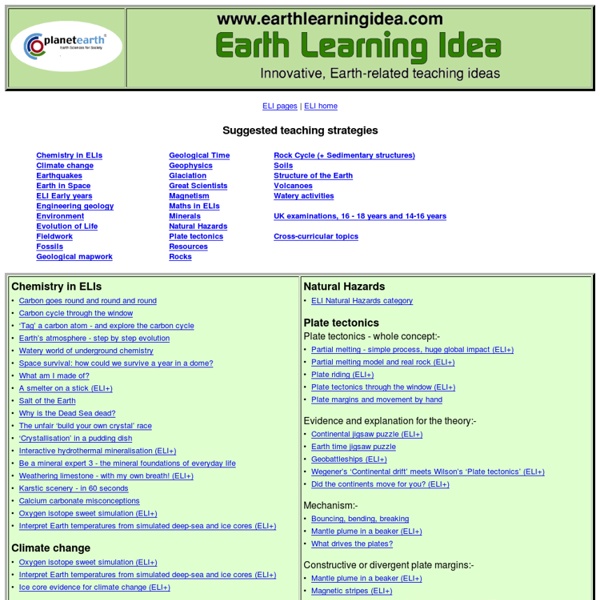It Takes Teamwork: How Endosymbiosis Changed Life on Earth
It Takes Teamwork: How Endosymbiosis Changed Life on Earthby the Understanding Evolution team In 1966, microbiologist Kwang Jeon was studying single-celled organisms called amoebae, when his amoebae communities were struck by an unexpected plague: a bacterial infection. Literally thousands of the tiny invaders — named x-bacteria by Jeon — squeezed inside each amoeba cell, causing the cell to become dangerously sick. Only a few amoebae survived the epidemic. However, several months later, the few surviving amoebae and their descendents seemed to be unexpectedly healthy. Had the amoebae finally managed to fight off the x-bacterial infection?
Virtual Labs
The links on this page are all VIRTUAL LABS offered by the Glencoe textbook company. These labs give the students the adventure of laboratory experimentation without costly supplies, worrisome environmental and safety issues, or time-consuming clean up. They are from all different areas of science: Biology, Physics, Genetics, Earth Science, Physical Science, and Chemistry. Please feel free to try these at home! Students will be directed to specific labs in class but there are over 100 labs offered here!
Mrs Humanities shares… 10 Geography Teachers to follow on Twitter.
Okay so this is something new I’m trying a new monthly feature on things that stand out to me. This could be anything from teachers to follow on twitter, interesting pedagogical practices, recently shared resources, news stories etc. Suggestions welcomed.
Soil Layers Activity With LEGO for Kids Earth Science STEM
Learn about the layers of soil with a fun hands-on LEGO activity. Our soil layers activity was a fun way to include a little earth science into LEGO play. We have tons of great Kid’s LEGO Activities for STEAM Learning! The other day we used our LEGO bricks to make a slice of the Earth and check out the LAYERS OF THE EARTH! I love using basic bricks to learn about new things. We have even made a LEGO VOLCANO and used a baking soda science activity with it!
Scientists Watch As Wasps Diverge To Become Separate Species
We often think of evolution as something which occurs slowly over millions of years, only being recorded in the fossils that are left behind. But evolution is gradual, with species constantly changing in response to a host of different pressures, from alterations in their environment to changes in other species they reply on. This last point, of species evolving and splitting in response to other species evolving and splitting, is a central concept in biodiversity, but is also a difficult one to prove. A new study has, however, apparently done just this.
Inquiry and Integration Across the Curriculum
Every time we open the local newspaper, listen to the evening news, or visit our favorite national online news source, we’re confronted with stories that directly or indirectly tell us something about the state of the planet. Whether it’s a debate about zoning ordinances for construction in wetland areas, the line item for fossil fuels costs in the annual school budget, local industrial soil contamination, or the price of gasoline at the pump, issues of environmental sustainability permeate our lives. Exploring the impact of human activity on the environment provides high school students with an opportunity to understand these issues from the inside out.
Fieldwork
Fieldwork is an essential component of geography education. It enables pupils to better understand the ‘messiness’ of ‘geographical reality’, develop subject knowledge, and gain a range of skills that are difficult to develop in the classroom alone. However, the value is not simply the ‘geographical’ value of experiencing such things as landscape features, busy urban streets and unfamiliar cultures which helps ground the pupils’ local environment in the context of the global. It also aids motivation and self-development. This resource aims to help teachers to introduce and develop fieldwork with students in both primary and second schools. It acts as a portal to existing resources on this and other websites, rather than as a self contained programme of guidance and activities.
Evolution in Paradise
We are pleased to bring you three exciting lessons inspired by the birds-of-paradise! These lessons explore the topics of science process, natural and sexual selection, behavior and heritability through hands-on activities and lively discussions… all with the help of the Birds-of Paradise Project videos. This free download is perfect for middle and high school classrooms.
Discover
Browse lessons and activities from EOL and our partners. Lessons and activities include relevant materials, EOL Collections and podcasts that can be used to supplement existing curriculum or on their own. These activities are aimed at upper elementary and middle school students but can be modified for elementary or high school students. Each lesson or activity is aligned to the Next Generation Science Standards (NGSS). Please contact us with feedback or suggestions.
Fold-out charts
Full-colour laminated charts designed for use outside. Over 70 titles in the series. Clear colour illustrations help you make a positive identification quickly. Small enough to take into the field - charts fold to B5 size (approx. 24 x 18 cm). Splash-proof and wipe clean.



